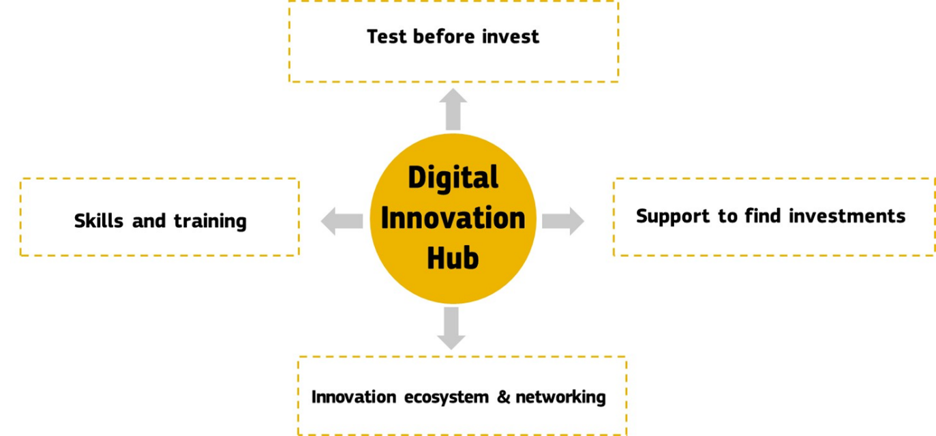What Digital Innovation Hubs Do?

Digital Innovation Hubs (DIHs) are supporting facilities that help companies embrace digital transformation. DIHs assist companies - mainly small and medium enterprises (SMEs), mid-caps, and low-tech companies - to become more competitive by digitalising their business, production processes, products and services.
However, DIHs go beyond the business community and assist all stakeholders wishing to digitalise their business operations.
The DIH concept is based on an innovation policy approach that aims to promote open innovation among stakeholders and enable co-participation and interaction with government stakeholders.
What kind of services DIHs offer?
DIHs act as one-stop shops, serving the digitalisation of enterprises (and other organisations) mainly focusing on their regions.
DIHs help customers address challenges in a business-focused way and with a common service model, offering services that would not be readily accessible elsewhere.
DIHs provide connections with investors, facilitate access to financing for digital transformations, and help connect users and suppliers of digital innovations across the value chain. Also, they foster synergies between digital and other key enabling technologies (ex. biotech, nanotechnologies, and advanced materials).
These services are particularly relevant to two types of enterprises. Firstly, companies that have a relatively low level of digitalisation. Secondly, companies that lack the resources or manpower to embrace fully digital transformation.
The services available through a DIH allow any business to access the latest knowledge, expertise, and technology for testing and experimenting with digital innovations relevant to its products, processes, and/or business models.
DIHs provide connections to investors and facilitate access to the financing for digital transformations. Also, they help to connect users and suppliers of digital innovations across the value chain.
DIHs portfolio
DIHs portfolio is based on four types of activities:

Test before invest includes experimentation with new software and hardware digital technologies to understand new opportunities and return on investments. It also includes demonstration facilities and piloting.
Skills and training to make the most of digital innovations. This entails train-the-trainer programmes, boot camps, traineeships, exchange of curricula and training material.
Support to investment funding including feasibility studies, developing business plans, incubation and acceleration programmes.
An innovation ecosystem and networking opportunities through marketplaces and brokerage activities.
Digital Innovation Hubs in the Western Balkans
The self-declared DIHs in the EU can register in the Catalogue of Digital Innovation Hubs. The Catalogue also features 32 DIHs from the Western Balkans.
Yet, the concept of DIHs is not well-known in the region.
Therefore, RCC mapped the region's DIHs in 2021, identified their needs and laid down prospective regional cooperation actions.
The mapping showed several important conclusions.
Firstly, policymakers adopt numerous approaches to "adapt" the DIH concept to their specific needs. Secondly, the majority of self-declared DIHs in the Western Balkans predominantly provide supplementary services.
This shows the mismatch between what a DIH is and what its roles should be, and what DIHs managers/owners believe their DIHs do.
Thirdly, it is implementing new technologies in SMEs is challenging and risky due to their limited knowledge and investment.
Fourthly, DIHs are not fully understood by the stakeholders in the region, partly because DIHs offer access to one or a couple of resources such as incubation, preparation and networking, as opposed to the whole cycle.
The main missing component is scaling startups or investment through instruments such as crowdfunding, venture capital, and angel investors.
While some WB's economies have innovation funds in place, others lack such mechanisms to boost their innovation ecosystems.
DIHs would benefit from a better defined and structured legal form to increase the odds of broader access to funding.
What DIHs need to develop in the Western Balkans?
Businesses in the WB should be better informed about the importance of DIHs and the benefits they can provide. It would be useful to provide networking opportunities to DIHs in the region.
Networking could support DIHs' development by exchanging experiences and good practices, organising training/events and focusing on tailor-made activities, and connecting the Western Balkan DIHs and EU DIHs to enable peer-to-peer learning.
Showcasing how DIHs could be set up is a simple, yet very powerful activity. For example, the WB may mimic the JRC's Catalogue to promote universities as DIH leaders across the region.
In addition, the WB's DIHs may benefit from Horizon Europe and other EU instruments.
Particular attention should be on pooling resources through various programmes and wider participation in large-scale projects with already established DIHs.
Pilot projects may be introduced to assist a broader knowledge transfer, upgrading competence centres to DIHs, creating synergies with hubs active in other advanced technologies, and federating existing projects funded by a public-private partnership.
Finally, it would be useful to establish partnerships programmes to connect operational DIHs with the ones at the early stage to foster rapid uptake of such initiatives. Providing already established funding practices to seed and develop new DIHs may lead to increased collaboration between DIHs.
